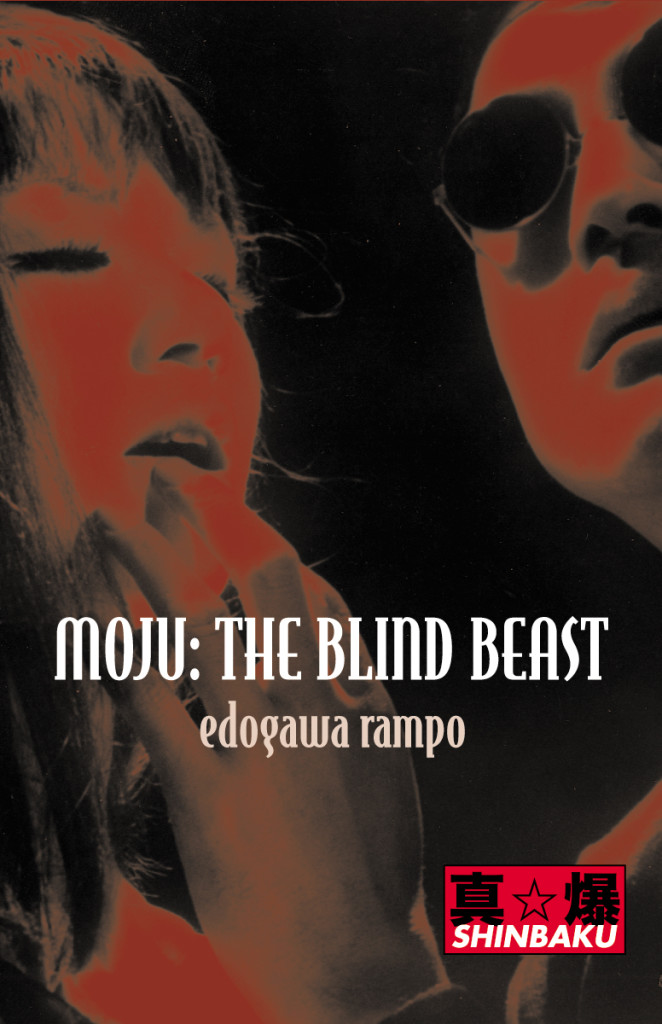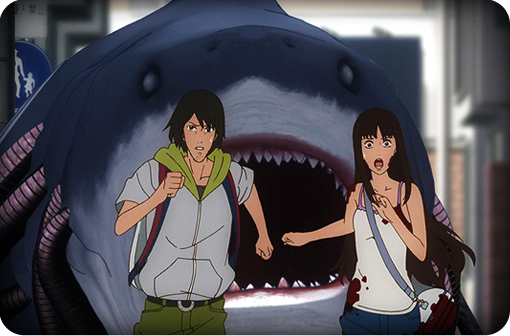 In 1925 Edogawa Rampo wrote one of Japan’s creepiest horror stories. “The Human Chair” was the literary equivalent of pleasantries from the mouth of an leering pervert – the events were tame, even funny at the end, but its subtext of sickness and depravity made it hard to forget.
In 1925 Edogawa Rampo wrote one of Japan’s creepiest horror stories. “The Human Chair” was the literary equivalent of pleasantries from the mouth of an leering pervert – the events were tame, even funny at the end, but its subtext of sickness and depravity made it hard to forget.
Moju: The Blind Beast recreates the same atmosphere, but now that subtext is matched with violent and gruesome events more in line with the Hollywood slasher movies it predates by forty years. It has moments of humour, as well as amusing Japanese political incorrectness (Hawaiians are described as “barbarous”, Westerners in general are “disgusting”), but the main impression The Blind Beast leaves is one of destruction and carnage, blood spraying the walls like an artistic fresco.
Singer Mizuki Ranko is being stalked by an blind man of artistic bent who is obsessed with touching the curves and contours of her body. Soon, she finds herself imprisoned in his underground maze, which has walls fitted out with rubber breasts and noses and legs. The man has an obsession with touching things, and craves the stimulus he cannot get from his eyes. He has chosen Ranko to fulfill his desires, and she still might not be enough.
I liked “The Human Chair” more, mostly because it’s more compact and focused, but The Blind Beast is an entertaining read and touches upon many similar themes. Rampo obviously wants to be more sexually explicit, but for whatever reason (fears of censorship or his own prudishness) he tends to imply or insinuate sex rather than outright state it. The effect is rather brilliant, and probably more disturbing for the fact that it isn’t explicit. I’m reminded of how Hollywood’s Golden Age occurred during the period when it laboured under the infamous Production Code.
The book has things to say about art – again, through allegory and inference. The book ends with the blind man conducting an art exhibit, showing a sculpture made from the pieces of various murder victims. A not-so-nice feature, but artists are often not-so-nice people.
The truth is, if The Blind Beast‘s artist goes to hell for his crimes, he might have to wait in line. John Lennon liked to tune up on his wife. So did Elvis Presley. William S Burroughs shot his wife in a drunken game. Allen Ginsberg is a member of NAMBLA. All these guys were members of the vaunted 50s/60s counterculture, back when people thought that art would be the force that saves us from the evil capitalists and what not. A nice idea, but maybe Rampo was right.
Maybe artists, deep down, are the worst people of all.
No Comments »
 In 2012, Ufotable adapted Junji Ito’s legendary manga into a 70 minute OVA.
In 2012, Ufotable adapted Junji Ito’s legendary manga into a 70 minute OVA.
As in the comic, millions of fish suddenly sprout legs and start migrating inland, causing massive destruction. It’s a silly story, but Ito found a way to make it creepy and compelling, and Ufotable doesn’t deviate far from his plot. All the basic points are touched upon briefly – often too briefly (Brevity is the soul of wit, but it’s the soul of laziness, too), and while a different take on the manga might have been ideal, I’m glad they did this. The few times they take the story in a new direction are nearly enough to ruin the entire movie.
There’s lots of fanservice here. Lots of animated bouncing breasts and heroines tripping over so we can see their panties. This is all wrong – Ito’s comics aren’t about cockteasing T&A crap. It disrupts the atmosphere, and takes things to the level of a western horror film. You start wondering when the guy in the hockey mask will show up.
They switched the genders of the main characters, presumably so they could show a nubile young girl getting molested by a giant octopus. The male character Tadashi is now a fifth wheel. He has no purpose in the story because Kaori is now Princess Peach and Mario rolled into one, simultaneously a damsel in distress and a plucky heroine. They also added some secondary female characters who provide T&A and are generally of no import to the story.
A lot of stuff seems awfully rushed, and things that were lingered on unpleasantly. The two chapters in the circus were my favourite part of Gyo, a trippy interlude that reveals things might actually be worse than anyone could ever imagine. But they come across awkwardly in the movie, and it wouldn’t have hurt if they’d been scrapped. The business with Dr Koyanagi is handled pretty shittily as well, and a dark and interesting character becomes an annoying Dr Phibes.
There’s some effective scenes. Kaori carrying an injured friend up a staircase with a giant walking shark charging up the stairs behind her, with the shark kept out of the frame so that we don’t know how far away it is…that’s a spectacularly effective shot, and my heart rate increases every time I see it. Junji Ito has lamented that you cannot easily control pacing in comics, cannot decide how fast the reader experiences the action, and Takayuki Hirao seems keen to show that he is under no such limitation. The special effects are pretty good, and seeing all those walking fish running around Okinawa was nice.
But the soul of Gyo went missing in the transfer. There’s none of the comic’s sense of the absurd made palpable and real. The movie feels campy and trite, and not very scary. The comic had a dense atmosphere. Ultimately the Gyo Anime serves as an exercise in how to adapt a comic almost flawlessly – and yet, somehow, not truly adapt any of it at all.
No Comments »
 Chyna’s autobiography is part of one of publishing’s more inexplicable trends: the sudden rush of pro-wrestling tell-all books. In the late 90s it seemed that everyone who stepped inside the WWF offices short of the pizza delivery guy was suddenly writing a book about it. The Rock published an autobiography…in 2000. Imagine that, writing your autobiography when you’re 27. It’s like if Steven Spielberg wrote his career retrospective after making Jaws in 1975.
Chyna’s autobiography is part of one of publishing’s more inexplicable trends: the sudden rush of pro-wrestling tell-all books. In the late 90s it seemed that everyone who stepped inside the WWF offices short of the pizza delivery guy was suddenly writing a book about it. The Rock published an autobiography…in 2000. Imagine that, writing your autobiography when you’re 27. It’s like if Steven Spielberg wrote his career retrospective after making Jaws in 1975.
As a general rule, wrestlers should not write tell-all books unless they’re about five years removed from the sport (and McMahon’s chequebook). Otherwise, you get weak, not-very-shocking accounts by people who promise to spill the beans and dish the dirt…but not all the beans, and not very much of the dirt. They’ve got to stay in the WWF/WWE’s good books because, hey, McMahon still might call and offer them another payday.
Chyna breaks the rule, with this book being written just one year after winning the WWF Intercontinental Championship, but it’s fairly interesting as these books go. We learn about her early life, beauty pageants, various odd jobs, how she got discovered, her quest to find breast implants that won’t rupture in the ring, and her shitty dad. If you want bitterness and bad-mouthing, there’s a lot of it here. If you listen closely, you can hear the sound of a hundred bridges burning. Wrestlers are usually all too willing to sling mud at each other, just so long as they don’t insult the federation.
There’s lots of photos, and some stories contributed by Triple H and Mick Foley. Mostly the book hits all the expected spots for a sports tell-all book, and it’s (ghost)written well. This is coming from someone who’s not a super huge fan of pro wrestling. I follow it like I follow the UFC – that is, I only follow the freaks and the misfits. It’s a credit to this book that it remains accessible to someone like me, sitting in the cheap seats.
It has one big weakness, and it’s the same thing you could say about Dwayne Johnson’s book – it came too soon. Obviously there was a cash cow to milk, but what would this book have looked like if it was published 10 years later? It would cover the termination of her contract, her sex tape, her substance abuse problems, her adult entertainment career – a story or two there, no? But that’s getting a bit too sordid, and the book would end on a depressing note. It is difficult to sell a story about female empowerment when your latest industry accomplishment is a movie called Backdoor to Chyna.
But if you want to get picky, Chyna’s porn career officially started with Chyna Fitness in 2000, which has Chyna doing circuit training while the camera zooms in on her cleavage. Towards the end I became convinced that it was a porn video masquerading as a workout tape, and my view hasn’t changed since then. Seriously, if you have a market of muscle fetishists to exploit and you don’t want to look too obviously sleazy, what do you do? It’s like Japan’s “Soaplands”, where women oil you up and molest you, and the business skirts legal arbitration by claiming it’s a massage parlour.
No Comments »
 In 1925 Edogawa Rampo wrote one of Japan’s creepiest horror stories. “The Human Chair” was the literary equivalent of pleasantries from the mouth of an leering pervert – the events were tame, even funny at the end, but its subtext of sickness and depravity made it hard to forget.
In 1925 Edogawa Rampo wrote one of Japan’s creepiest horror stories. “The Human Chair” was the literary equivalent of pleasantries from the mouth of an leering pervert – the events were tame, even funny at the end, but its subtext of sickness and depravity made it hard to forget.

